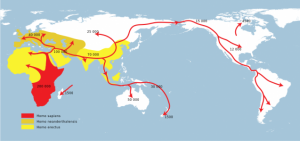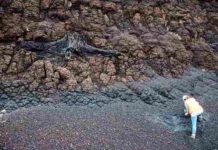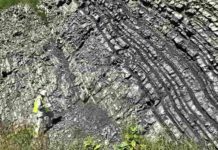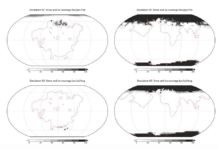
“Forget this image,” says Dimitra Papagianni, pointing at the depiction of human evolution projected behind her: an ape crouched on all fours, followed by the early hominids carrying rock tools and spears, walking ultimately to the modern human form. While the image is iconic, Papagianni explains that the casual saunter from species to species doesn’t do justice to the 2-million-year epic story of how modern humans beat out their Neanderthal cousins to survive and thrive in the bitterly cold lands of modern day Europe.
Last Wednesday Papagianni, a researcher from the Centre for Archaeology of Human Origins at the University of Southampton, gave the inaugural seminar for the newly minted Center for Climate and Life at Columbia University and the Lamont-Doherty Earth Observatory. In her talk, titled “The Neanderthal Paradox,” she explained the differences between the Neanderthals, a species that went extinct, and the ancient humans, our tropical-adapted forebears that would defy all odds and usurp Neanderthals as they migrated from Africa and into the chilly north. It was a talk that wove together culture, climate change, genetics and evolution. Overall, it was an apt introduction to usher in this new division of Climate and Life.
Though they were closely related, Neanderthals and ancient humans were different species. Papagianni compared the skull of a Neanderthal to that of a human. The difference is clear. “Think of the skull of a human as a soccer ball, and the skull of a Neanderthal as a football,” she says. This sports analogy goes a step further. Like a soccer player, humans are lean and well-suited to running. Neanderthals have stocky statures and barrel chests, more like the stereotypical football player. Because of this, Neanderthals were better adapted to colder weather than ancient humans who originated in the tropical climates of Africa.
“What you likely know about Neanderthals,” Papagianni says, “it’s that they’re supposed to be stupid.” This is a tough rap, but archaeological research suggests they were advanced enough to make clothes and build fires, which would have been critical to survive the cold weather. They also used stone tools. Additionally, based on the size of their skulls, the brains housed with them were likely large enough to warrant some form of language capability. This language hypothesis is supported by modern experiments that show learning how to make and wield stone tools required some form of verbal instruction.
Papagianni laughed as she described the experiment. Groups of graduate students attempted to learn how to make stone tools with and without verbal cues. Even after hours of work, fashioning a working Neanderthal-style tool from stone was near impossible without some form of verbal instruction.
Given their adaptation to cold climes and their advanced, albeit under-appreciated, skills, how were Neanderthals beaten out by their human counterparts? The answer lies in a combination of culture and genetics that enabled the successful radiation of humans.
Humans had diets higher in energy-rich meat that could support smaller stomachs and bigger brains. They invented tools with multiple uses that could adapt to different circumstances. They had more advanced language capabilities to pass on these skills. They were smarter; one could almost say they had more culture. “And if you’re smart and you can speak,” Papagianni quips, “you want to go to Europe.”
So the humans migrated north. This is where the genetic factors come into play. Neanderthal communities became fractured. As they grew more and more isolated, their gene pool evaporated into a spattering of puddles. This so called genetic bottleneck can lead to the demise of a species when genetic diversity gets prohibitively low.
Papagianni explained the current theories for how humans were able to persist in the North at the expense of Neanderthals, but she ended on an ongoing research question: Why did humans leave Africa in the first place? Their migration could have been sparked by competition, climate change or simply a great hallmark of human nature, curiosity. Over the past 2 million years, humans have proven to be a remarkably successful species. In fact, humans are the only species on the planet with a global distribution. In order to figure out how we might fare in the future with a changing planet, it’s critical to get insight from our past. The research of Papagianni, as well as the new Center for Climate and Life, will yield this essential insight into Earth’s past and future, and our place within it.
Note: The above post is reprinted from materials provided by Earth Institute, Columbia University.










